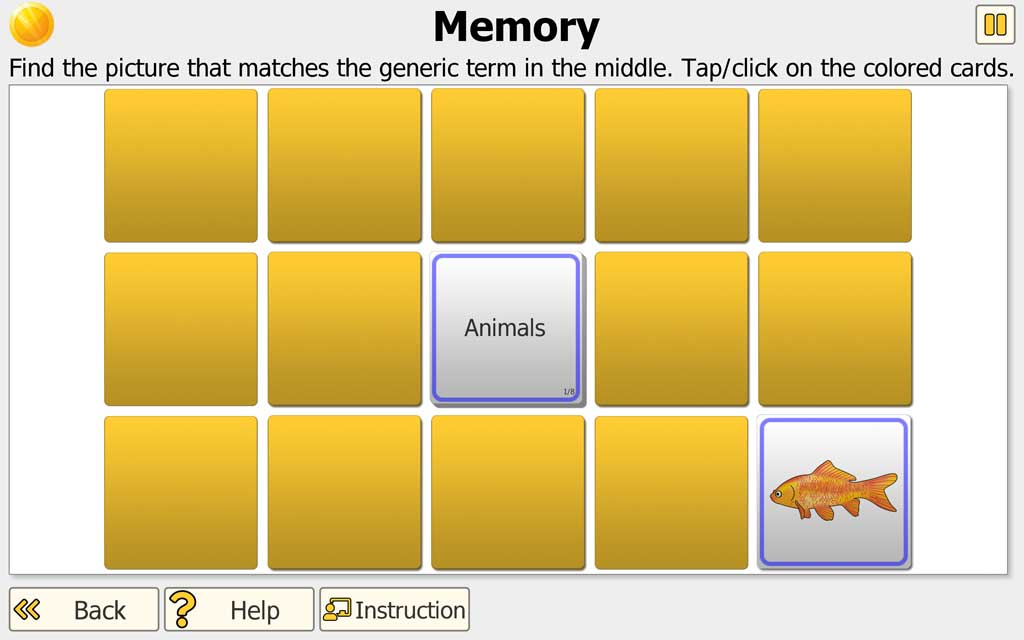
































































Training goal
The training exercises short and medium-term memory for visual content.
By assigning terms to generic terms, the semantic memory is improved at the same time.
Important processes
There are three important processes involved in creating memories.
- Encoding
- Storage / consolidation
- Retrieval
Encoding
Encoding is the translation of information from the outside world (or the body) into a neural code so that the brain can read this information. This also means that the information represents in the memory but is not yet permanently stored.
The more the patient works with strategies, the more successful the encoding process is.
Memory strategies can be practiced with the HeadApp program “Learn It”.
Consolidation
Consolidation means processes in the brain that lead to the permanent storage of information. The connections between the nerve cells that process the information belonging to an episode are strengthened. This creates networks of nerve cells that have stored the information associated with a memory.
If we frequently work on a task and repeat it the following day, the connections between the nerve cells that are responsible for processing this information are strengthened. If similar information is added, networks are created between the associated nerve cells.
Retrieval
The retrieval of stored information from the memory can happen consciously or unconsciously. If you are asked about an animal that barks and answers “dog”, it is a conscious call. However, if you come across a stimulus like an image of an apple on the thought of other types of fruit, it is an unconscious retrieval.
Description of task
The gameplay is that of a memory game. In the middle is a game stack with a number of generic term cards. The number rises with difficulty level. The top card is face up. Around it, depending on the level of difficulty, a different number of motif cards are laid out.
One of the cards laid out is turned up. the program checks whether this fits the generic term (e.g. generic term “job”, motive “postman”).
On levels 1-9, generic terms and motifs that belong together are outlined with the same color. There is no colored border at higher levels.
The pair of cards is removed for matching cards. If the cards do not match, the middle card remains open (level 1 – 15) or the middle card is exchanged (from level 16). The card that was laid out is covered again. The player tries again until a pair of cards has been found. In this case the card changes in the middle and a new generic term is specified.
From level 10, the cards found are replaced by new ones, so that the same number of cards face down can always be found.
From level 19, all cards are first exposed for one minute. The duration of the presentation is shown by a time bar.
After memorizing, a suitable card for the generic term should be found, as before. In a second step, the user should indicate which card it initially memorized (delayed, overlaid retrieval of memory content).
A game round ends when a motif has been found for all generic term cards. In the event of non-solutions, the generic term card is placed under the middle pile again so that it remains in play.
After a specified number of game rounds, which are completed within a defined time, the difficulty of the task increases.
Procedure
In the start window for all therapy programs select the “All exercises” area, here the “NEUROvitalis” tab. Click on the training exercise “Memory – Vita Mem”.
A window appears for selecting the level of difficulty and the duration of the training.
Level of difficulty
So that the exerciser does not overwhelm himself, the training begins with a low level of difficulty. All other levels are locked with a lock, which must be opened by completing the previous task.
If a therapist wants to skip levels of difficulty, he can switch on the “Therapist can start all levels” option in the “Patient -> Edit” menu.
Training duration
In general, 20 minutes of training is recommended. A too long training session leads to a loss of attention, the patient makes mistakes and becomes frustrated.
For severely affected people, the training duration should e.g. reduced to 10 minutes (attention span). In this case, several sessions a day make sense.
Progress in therapy
The therapy progress is saved automatically. A new session continues with the difficulty in which the last session ended.
The “Results” window offers various views of the course of therapy (button at the bottom of the “Therapy modules” window).

